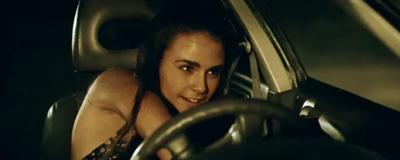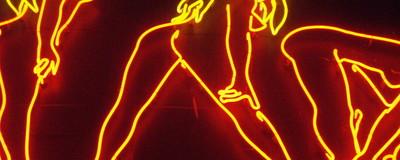My Terrorist, My Freedom Fighter: White Terrorism in American Cinema
By Mayukh Sen

Patty Hearst before her kidnapping. Photo via Flickr user Simon Murphy
It's a story we were born knowing. In 1974, the year that Chinatown came out and ABBA sang "Waterloo," Patty Hearst was just a rich girl living in Berkeley when the Symbionese Liberation Army (SLA) kidnapped her. In captivity, she allegedly suffered unthinkable violence and fell victim to Stockholm Syndrome. She became exactly like her captors. She adopted the pseudonym Tania. She robbed a bank. She played with guns. She became a fugitive.
After she got free, pop culture mythologized Patty Hearst—on posters, in Patti Smith songs, and in the movies. The SLA's roots in black resistance were largely erased as she morphed into a tidy white girl myth. She was the subject of Patty Hearst (1988), directed by the man who wrote Taxi Driver, starring Vanessa Redgrave's enormously gifted daughter, Natasha Richardson.
In the movie, Patty Hearst was exactly as we have always imagined her: a woman of many competing faces residing in the same body. She was a newspaper heiress. She was a freedom fighter. She was a terrorist. And she was white.
This is the story of white terrorism in American cinema. It is a machine that affords white terrorists the luxury of sympathy while denying those same privileges to terrorists with skin that's any other shade. White terrorists are gifted the richness of nuance and humanity in the wake of violence we call "senseless." The white killer appears, simply, as a wandering, mistaken deviant, free of context or cause.
One person's terrorist is another person's freedom fighter. And the split is easy to muddy when we go to the movies. Terrorist or freedom fighter, Satan or saint, monster or victim? When they have white skin, they get to have it all.
Terrorist or freedom fighter, Satan or saint, monster or victim? When they have white skin, they get to have it all.
What makes a terrorist in America? The term has most often operated as a catch-all term for a person whose skin isn't white, exacting politicized violence on those who don't deserve any violence at all. The word means everything and nothing. With each mass killing we inch towards a consensus, and suddenly our idea of terrorism goes into a tailspin.
We saw what makes a terrorist in a film like Patty Hearst. Natasha Richardson, before she died tragically young, was an actress whose motor always ran a little fast. She had a face so wide and expressive that she always seemed on the cusp of exploding with emotion: rage, thrill, fear.
In Patty Hearst, we saw in Richardson's alert eyes glimpses of the woman Patty was and the woman she'd become. There was a monster living inside this girl—the granddaughter of William Randolph Hearst, that symbol of the American spirit—and she was waiting to be emblazoned by ideology. She was a victim of ideologies bigger than herself; she also possessed the will and fortitude to make bad, violent decisions. She had no agency and she also had a lot. Patty Hearst—neither here nor there, always with the privilege of being in a limbo—was complicated. Her world was complicated. She was white.

Warner Bros. Entertainment. Photo via Flickr user _nijoker_
Heath Ledger's Joker of The Dark Knight (2008) also lived inside a complicated world. Ledger won a posthumous Oscar for capturing just that. Yet at no point in the storied history of Batman going to the movies had the Joker seemed as charged with feeling, complexity, and disgust as when Ledger played him. His world was off-balance, but what an intoxicating world it was. Ledger worked tirelessly—maybe even worked himself to death—rewiring our naive cultural imagination, showing us a Joker that held new, disturbing shades beyond the old evil.
Wasn't Travis Bickle a terrorist, too? Someone who had a political agenda and would sharpen the means for getting that point across with violence, all cresting in that blood-soaked dream of a finale?
The same was true of Derek, the white supremacist of American History X (1998) played by Edward Norton, who went on to nab an Oscar nomination for the part. Norton was a fresh talent back then. He could hide his anger, frustration, and torched pain in the clench of his jaw better than Keira Knightley. He forced us to run our fingers through the pathology of a man we would never like to know: a neo-Nazi.
You could argue that that Travis Bickle, the anti-hero of Martin Scorsese's Taxi Driver (1976), was a terrorist. He had a goal, but we got so deep under his (white, white) skin that his goal seemed noble. As Robert de Niro played him, Travis Bickle is an intoxicating enigma. He was consistently on the verge of unbalance, his mind like a child learning how to walk. It is a masterpiece of a performance. But he had to have been a terrorist, right? Someone who had a political agenda and would sharpen the means for getting that point across with violence, all cresting in that blood-soaked dream of a finale?

Travis Bickle. Photo via Flickr user annie_is_okay
What is most frightening and unsurprising is that these white terrorists of American movies have absorbed themselves into a cultural lexicon of "cool." Aged 16, was there anything cooler than worshipping the art Heath Ledger created in The Dark Knight? It's passé to declare that you just don't really like Ed Norton in American History X, or to shun Robert De Niro in Taxi Driver. These terrorists are tied to American notions of masculinity. We marvel over its contours. But could we criticize the "newspaper heiress" Patty Hearst, the woman whom Patti Smith spit out applause for in one of her songs? The mother of a now-famous model? We have venerated her, too.
The white terrorist remains a cipher in the media. The minute a new one strikes, the leaders we trust find themselves in an unending refusal to know why he or she did it, even when the reasons are obvious. Dylann Roof was not born in a vacuum. Neither was Michael Page, the man who shot and killed six people at a Sikh temple in Oak Creek, Wisconsin a few years ago. Nor was Craig Hicks, the guy who murdered three Muslims in Chapel Hill four months ago.
To be a white terrorist in American cinema is to enjoy a very basic right: to be complicated, to be messy, to be human.
We lament that we will never understand what drives these men even when it is clear: the canker sore of white privilege. We will stump for the death penalty because, we claim, one-offs like Roof are not worth our tax dollars. We foolishly believe we won't see their kind again. And then the next one arrives. The white terrorist is an apparition who just sort of happened, allowing white America to absolve itself of its culpability in creating him. The movies reflect this, humanizing white terrorists so poetically that their cases seem unique, uncommon, beautiful.
Look at Kathryn Bigelow's Zero Dark Thirty (2012), where the terrorist exists as an abstract brown whisper. We hinge our expectations on Maya, the woman who looks like Liv Ullmann with a less amorphous face. She is rapt with the disease of pursuit, searching for her terrorist.
Who is this terrorist? He's an unseen, mythical menace who presides in the Khyber Pass or in the bazaars of Abbottobad. Maya appears relentless in search of this beast. Jessica Chastain's face wears American obsession and entitlement beautifully: It's the face of a woman looking for the right dress in a department store during the holiday season. The search is burdening her. You can see it in the way her spirit deadens even after he's killed. And in the end, when that weight finally lifts off her, she is just... exasperated.

Jessica Chastain's irritated stare in Zero Dark Thirty. Annapurna Pictures
Zero Dark Thirty hinges on what well may be, as Seymour Hersh provocatively suggested last month, a great lie: that our country is great and mighty. The film's climax, in which American personnel raid bin Laden's compound, reveals Bigelow's great tricks. Her camera focuses solely upon the soldiers breaking in. We hear faint, ailed cries of children screaming in the background. Her camera avoids these children. To her, they are just collateral damage to the necessary heroism that is the American military. But when they scream, it is the sound of real terror.
In the wake of the terrorist attack in Charleston, the word terrorist and its many meanings were thrown into flux. Some, like Glenn Greenwald, wrote of the word's increasing meaninglessness; many others wrote about the urgency of classifying Roof as a terrorist. BuzzFeed's Joshua Hersh posed an idea that seemed remarkably radical when it really shouldn't: that we should consider terrorism "in its full cultural and human context."
American cinema accomplishes the feat Hersh speaks of, infusing the demon with humanity. But that terrorist? That terrorist is almost always white. To be a white terrorist in American cinema is to enjoy a very basic human right: to be complicated, to be messy, to be human.
RELATED: The Female Fighters of Kurdistan
Who will play Dylann Roof in the biopic that will inevitably be made of his life? The question is nauseating to think about so soon. Perhaps the man who plays him will be a skilled and trained actor. Perhaps he will just be playing dress-up, cutting his hair into the shape of a decorative bowl and adopting that man's crazed, monstrous gaze as an affect.
He will probably win an Oscar for it, because that is the machine of the spectacle of white terrorism in America. White terrorism is always human, because plum roles go to white actors, and that is the nature of this brutal game. In the movies as in the larger media landscape, white terrorism always clamors for our deep attention into the individual psyche that owns it, rather than the pressures that have created it.
And what about those actors who play the victims: Cynthia Marie Graham Hurd, Susie Jackson, Ethel Lee Lance, Depayne Middleton-Doctor, Clementa Pinckney, Tywanza Sanders, Daniel Simmons, Sharonda Coleman-Singleton, Myra Thompson? Our perverse fascinations do not extend to the victims. They rarely get a nod.
Follow Mayukh on Twitter.




Comments